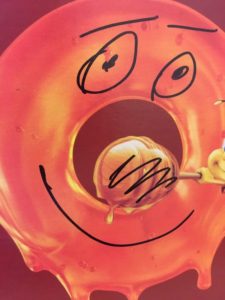Have you ever read a sign wrong and liked it better that way? Our family went “rustic camping” a couple of weeks ago, and we passed a notice by the road that said “You are responsible for your refuse”. This usually means, “Hey, pick up your trash, kid.” but I saw “refuse” for its literal meaning – to be unwilling to do something.
My gears started to shift.
Things happen in life. Whether it’s an opportunity that comes my way or a problem that blocks my path, no one can force me to change. But if I choose not to grow, take risks, and make the next move forward (however scary) then I need to take responsibility for my choice.
I am responsible for my refuse.
Most of the time, I don’t think we realize when we are refusing to change. For me, sometimes I get into a routine that works, and I think I’m all set. After all, if someone isn’t inviting you to jump into a cold lake, are you really refusing to go?
Of course, there are times when refusing to do something is a good thing. Not every opportunity can or should be taken. But I have refused so many good things in life.
I have refused to believe. Refused to put the work in. Refused to give someone a chance.
Those devastating refusals are on no one else besides me. But I don’t have to stay in a state of quiet or constant refusal. And if I am responsible for my refuse, then that means I also have the ability to change it. The transformation could be amazing, if I refuse to doubt.
You are responsible for your refuse. The question is: What are you going to do with it?
Until next time,
Invent your story
I can’t take credit for the cool faces on all of these boxes. I have an artist in my home who learned this technique from a buddy. Since my son took it up, our home has exploded with fun faces that bust up the doldrums of household routines.

Just for giggles, here’s my how-to tutorial for Cereal Box Sharpie Art:
1.) Choose a cereal (or other) box.
2.) Grab a sharpie.
3.) Get creative.

How long has it been since you’ve given yourself complete creative freedom? When was the last time you recklessly abandoned the rules and thought, “What else could this be?” The ingenuity of this art form is its out-of-the-box thinking. Sorry guys, it just had to be punned.
Just in case you think I’m off my rocker, I’ll let you in on a little secret: I’m not a super-great artist. I love art, and I marvel at the classic, great artists who’ve earned every bit of their fame. But I am not, and will never be, one of those men or women.
I’m more of an “art-inspires-me-so-I-create” kind of artist. A lot of my work is just odd. I like it that way. But why in the world do I put it online for you to see and try for yourself?
Here’s the thing: I don’t care what category your profession falls under – healthcare, hospitality, computer software development, or waste management – every job needs innovative thinking. Are faces on cereal boxes innovative? Maybe, but they definitely shake things up, and they’re reminders.
Reminders that things can change.
So, if you’re stuck in any way, shape, or form in life, grab a sharpie and a box. Change it up! Remind yourself that even good things can be a little brighter when you add your creative thinking to them.
Until next time,
Invent your story

This seems like the easy part of creating an invention center – you just get the supplies you need. The thing is, without a method to the madness, it’s just madness. So here are three plumb line questions to keep you stockpiling instead of just making piles.
Does the material fit into the goal of your invention center?
I know I haven’t brought up the term “goal” in the context of your invention center before, but if you’ve come this far, you probably have a good idea of what yours is already. (If you haven’t read the first two posts on creating an invention center, you can read what it is and Part 1 to get caught up.) If you’re woodworking, you’ll need wood, screws, a drill, etc.
This is the no-brainer stuff to have around. Without a stocked area, you’ll get bogged down looking for that lost paintbrush or copper wire. This is why we’re making an invention center.
How much do you need to get started?
Sometimes the zeal to create can take over, and you end up with a lot more than you need – especially if it’s freebie stock. Like toilet paper rolls. There are tons of art and engineering projects you can do with toilet paper rolls. But if you keep saving and don’t use them, well it can just start to get weird.
There has to be a FULL point. Then move on.
Did you throw a wrench in your plan?
If the answer to the last question is “nope” – then it’s time to find that wrench and throw it into the stockpile! Hear me out on this one. If you want to create a maker’s space, that’s great, but this is a defining moment for your invention center. You want to have something in your invention center that challenges you to break the mold. More than something. A fair lot of things. An acorn from last fall’s hike. A bunch of rusty nails. One red sock.
These are the grains of sand that help your creative oyster make a pearl.
Until next time,
Invent your story
